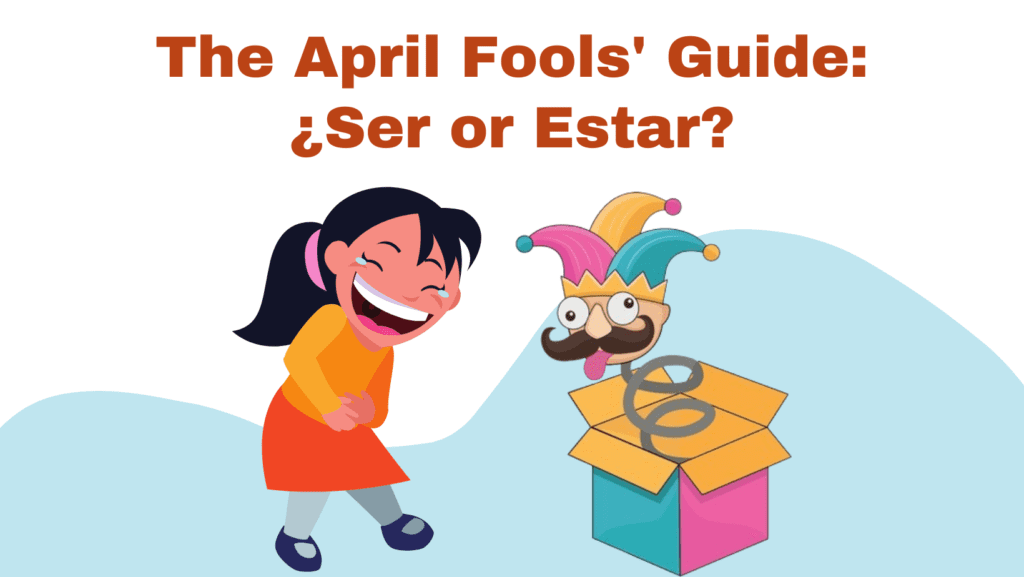
Spanish Grammar for Fools!
Hey, Fools! April is here, and you know what that means – time to brush up on your Spanish skills with a twist of April Fools’ flair! Today, we’re diving into one of the trickiest aspects of Spanish grammar: the eternal debate between “to be” and “to be.” What? Yes! Let´s introduce you The April Fools’ Guide to Ser or Estar.
Ok, guys! Get ready for a linguistic adventure filled with subtle humor, witty examples, and a sprinkle of April’s Fool mischief.

Ser or Estar: That Is the Question
Ah, “ser” and “estar” – the dynamic duo of Spanish verbs that often leave language learners scratching their heads. Are you feeling confused yet? Don’t worry; we’re here to shed some light on this grammatical conundrum.

Ser, the Reliable Rock
First up, let’s talk about “ser.” Think of “ser” as the steady anchor in the stormy sea of Spanish grammar. It’s used to express inherent qualities, permanent characteristics, and essential traits. For example, “Soy inteligente” (I am intelligent) or “Soy alto” (I am tall), Soy guapo (I’m handsome). Remember, when you’re describing something that’s part of your essence or identity, reach for “ser.” ¡Sí! ¡Claro, soy muy guapo!

Estar, the Fickle Friend
Now, onto “estar” – the unpredictable wildcard of the Spanish language. Unlike its steadfast counterpart “ser,” “estar” is all about temporary states, conditions, and locations. Feeling happy? “Estoy feliz.” Feeling silly? “Estoy tonto.” It’s as simple as that! Just remember, if it’s fleeting or subject to change, “estar” is your go-to verb.

Navigating the Gray Areas
But what about those tricky situations where it’s not so clear-cut? Fear not, intrepid language learners; we’re diving headfirst into the gray areas of Spanish grammar – where “ser” and “estar” blur the lines and keep us on our toes.
For example, let’s consider the phrase “Soy gracioso” (I am a funny person) versus “Estoy gracioso” (I am being funny). While “soy gracioso” implies a permanent quality of being humorous, “estoy gracioso” suggests that you’re currently acting funny or behaving in a humorous manner. See the difference? It’s all about context!
Similarly, “Soy tonto” (I am foolish) might imply a more fixed characteristic, while “Estoy tonto” (I am feeling foolish) could indicate a temporary lapse in judgment or intelligence. See how nuanced Spanish can be?

Characteristics Aren’t always Characteristics!
Yes that’s the case at least for the adjectives above mentioned: “guapo” and “alto”. If it is well-known that “inteligente” can only be a characteristic in both English and Spanish, it is also true that guapo (handsome) and alto (tall) can be conditions as well. But I can be guapo but also look more guapo today, right?
Entonces, soy guapo pero hoy me puse mucho mas guapo (I am usually handsome, but today I looke even much better than usual). Now? You understand how easy the difference is correct?

Yes! I am sexy and I know it!
Think about it: If I got money, I can probably get more attractive because I can get surgery to look taller and good-looking. Well, it doesn’t have to be a drastic change to explain the changing condition of “estar”.
The verb “estar” indicates change, process, transition, result. For instance, If I have a party, I need to take a shower, get all dressed up and polished up so people would tell me: “estás guapo”.
In this case, it means “you are looking good” or “you look handsome”. Just so you know it is not just about taking the shower but about the whole result of looking better than usual. If on the other hand, they say “eres guapo”, I would say: Yes! I am sexy and I know it.

“¡Qué alta que estás!”
Let’s provide more context for you to understand the changing nature of “estar”. Let’s say you haven’t seen your niece since she was 5 years old. Now that she is 10, you would likely react using this expression: ¨¡Qué alta que estás!¨ “How tall you’ve gotten!”
Now that she is 10 she feels like playing with her mom’s high heels and she would say: “¡Mira tío, estoy alta!” (“Hey Uncle, look, I got taller!”) You see in both cases “estar” is the result of a process and a changing condition from the usual state.

Embracing the April Fools’ Spirit
Now that you’ve mastered the art of “ser” and “estar,” it’s time to put your newfound knowledge to the test – with a playful twist, of course! This April Fools’ Day, surprise your amigos with some clever wordplay and linguistic mischief.
Instead of just saying “Soy estúpido” (I am stupid), why not playfully declare, “Estoy estúpido hoy” (I am feeling stupid today)? It’s a subtle nod to the temporary nature of your current state – perfect for April Fools’ hijinks! So your friends would smart you our responding: “Eres estúpido” meaning that’s your natural state and not a temporary condition as you just argued.
Disclaimer: In Spanish “estúpido” has a stronger insulting connotation compared to English. So, think about it twice before you use it. “Tonto” or “Bobo” can have a similar meaning to “stupid” or “silly”. ¡Qué difícil es el español!

¡Viva el español!
So, there you have it, amigos – a crash course in the whimsical world of “ser” and “estar,” served up with a side of April Fools’ fun. Remember, language learning is all about embracing the journey and having a few laughs along the way. ¡Viva el español! Into more fools like yourself?

Find More Fools Like You!
Please find our section April Fools to read about the cool origins of this celebration related to the Roman calendar and the following Caesar’s and Gregory’s changes to finally get to our current calendar.
Learn about all the changes underwent by our calendar going to our Leap Year section. Because Roman is related to Romantic, check out our sexy blog next.

Sexy, Creepy & Drunky Spanish!
Look for dirty phrases in our sections called El Sexy Chupacabras and Things Spanish People Say in the Bedroom. If looking to laugh, and maybe freak out more, during this day, check out our section Language Bloopers and Legends & Folktales for more fun stories.
If you wanna understand the difference between “ser borracho” and “estar borracho”, check out our section called “Alcohol rhymes with Spanyol”.
If you are too drunk to understand the difference between “ser borracho” and “estar borracho”, that’s ok. At least, you will believe that you are speaking Spanish better than ever. Yes! The April Fools’ Guide to Ser or Estar and the liquor of courage will help your Spanish.

Red for Free
And hey, if you’re feeling extra adventurous, why not join us at Kasa de Franko for some free Spanish lessons? We promise it won’t be an April Fools’ prank – just a chance to hone your language skills and have a blast while doing it.
You may be wondering: Who the heck is Kasa De Franko? Kasa de Franko provides private and group language lessons. Our KDF Blog help students with their Spanish grammar like this April Fools’ Guide to Ser or Estar
As a longstanding language school in San Jose and the San Francisco Bay Area, we have been serving our community for over a decade, situated at the heart of the Silicon Valley.
Find out more by clicking the red button for your Free Spanish Class Pass! Hasta luego, Fools! Always remember….

